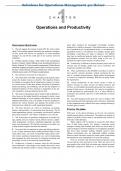Exam (elaborations)
Solutions for Operations Management: Sustainability and Supply Chain Management, 4th Canadian Edition Heizer
- Course
- Operations Management
- Institution
- Operations Management
Complete Solutions Manual for Operations Management: Sustainability and Supply Chain Management 4ce 4th Canadian Edition by Jay Heizer, Barry Render. Full Chapters Solutions are included Operations and Productivity Operations Strategy in a Global Environment Project Management Forecasting De...
[Show more]



